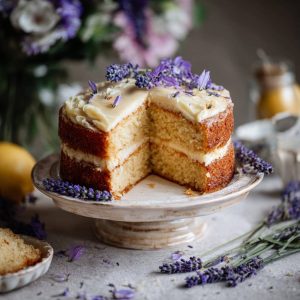Line your baking pan carefully: There’s nothing worse than a cake sticking to the pan, so always line your pan with parchment paper. I recommend leaving an overhang on the sides to make lifting the baked cake out much easier.
Measure your flour accurately: Using too much flour is the leading cause of dry, dense cake. For best results, weigh your flour with a digital kitchen scale. If you don’t have one, use the spoon-and-level method—fluff the flour first, spoon it into your measuring cup until overflowing, then level it off with a butter knife.
Avoid overmixing: Overmixing often leads to a dense and dry texture. Mix the batter only until the flour streaks disappear. Use a low mixer speed or stir gently by hand to prevent overworking the batter.
Allow the cake to cool completely: Be patient and wait until the cake is fully cooled before adding the lavender glaze. Pouring glaze on a warm cake will cause it to run off the sides rather than set properly.
Achieve the perfect glaze consistency: To get the thick, luscious glaze seen in photos, add milk one tablespoon at a time until you reach a nice drizzle consistency—usually about 2 to 3 tablespoons, depending on humidity. For a thinner, more subtle glaze, increase the milk to 4 or 5 tablespoons.
Consider skipping the glaze: If you prefer a more simple, breakfast-style treat, feel free to leave out the glaze and enjoy the cake alongside a cup of tea or coffee.

Lemon Lavender Cake Recipe
Lemon Lavender Cake combines zesty citrus with delicate floral notes for a moist, fragrant dessert perfect for any occasion. This elegant cake balances fresh, bright flavors with subtle sweetness and can be customized to suit various dietary preferences.
Ingredients
Cake Ingredients:
- 1 cup 200 g / 7 oz granulated sugar
- 2 tablespoons lemon zest
- 3 tablespoons culinary lavender
- 3/4 cup 170 g / 6 oz salted butter, softened to room temperature
- 3 large eggs at room temperature
- 3 tablespoons lemon juice
- 2 cups 240 g / 9.5 oz all-purpose flour
- 1 teaspoon baking powder
- 1/2 cup 120 ml / 4 fl oz whole milk, at room temperature
Lavender Glaze Ingredients:
- 1 1/2 cups 180 g / 6 oz powdered sugar, sifted
- 3 to 4 tablespoons whole milk
- 1/2 teaspoon lavender extract
- 2 to 3 drops purple food coloring
Instructions
- Prepare your workspace by preheating the oven to 350°F (180°C / gas mark 4). Grease the bottom and sides of a 9x5-inch (23 x 12 cm) loaf pan, then line it with parchment paper, leaving the paper to hang over the edges for easy cake removal.
- In a medium bowl, whisk together the flour and baking powder, then set aside.
- Create the lemon lavender sugar by placing the granulated sugar, culinary lavender, and lemon zest into a large mixing bowl. Rub the lemon zest and lavender buds into the sugar to release the oils and infuse the sugar with their aroma.
- Add the softened butter to the infused sugar mixture and cream together using an electric mixer until the mixture becomes light and fluffy, about 2 to 3 minutes.
- With the mixer set to medium speed, add the eggs one at a time, fully incorporating each egg before adding the next. Use a rubber spatula to scrape down the bowl sides as needed. Then mix in the fresh lemon juice.
- Add half of the flour mixture to the wet ingredients and mix until just combined. Pour in the milk, mixing gently, then add the remaining flour mixture and stir until the batter is smooth with no visible flour streaks.
- Pour the batter evenly into the prepared loaf pan, smoothing the top.
- Bake for 50 to 60 minutes, or until the cake’s top is golden brown and a skewer inserted in the center comes out clean or with just a few moist crumbs, but no wet batter.
- Allow the cake to cool in the pan for 15 minutes before lifting it out using the parchment paper overhang. Transfer to a wire rack to cool completely and remove the parchment paper once cold.
- To prepare the glaze, whisk together the sifted powdered sugar, milk, and lavender extract in a medium bowl until smooth. Add a few drops of purple food coloring to tint the glaze. Adjust consistency by adding more powdered sugar if too thin, or more milk if too thick.
- Drizzle the glaze over the cooled cake loaf and let it set for a few minutes. Slice and serve your beautifully flavored lemon lavender cake.